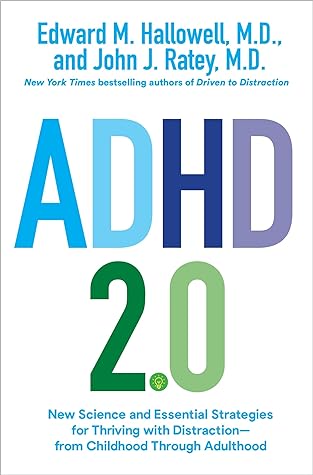More on this book
Community
Kindle Notes & Highlights
Read between
April 25 - April 28, 2024
A person with ADHD has the power of a Ferrari engine but with bicycle-strength brakes. It’s the mismatch of engine power to braking capability that causes the problems. Strengthening one’s brakes is the name of the game.
But if you were to climb up into our heads, you’d discover quite a different landscape. You’d find ideas firing around like kernels in a popcorn machine: ideas coming rat-a-tat fast, and on no discernable schedule. Ideas coming in spontaneous, erratic bursts.
“Sometimes it is the people no one can imagine anything of who do the things no one can imagine.”
We’ve got an overabundance of attention, more attention than we can cope with; our constant challenge is to control it.
ADHD as a complex set of contradictory or paradoxical tendencies: a lack of focus combined with an ability to superfocus; a lack of direction combined with highly directed entrepreneurialism; a tendency to procrastinate combined with a knack for getting a week’s worth of work done in two hours; impulsive, wrongheaded decision making combined with inventive, out-of-the-blue problem solving; interpersonal cluelessness combined with uncanny intuition and empathy; the list goes on.
An itch to change the conditions of life.
Aptly named, the TPN gets you down to work. You’re deliberately doing something and you are intent on it, unaware of much beyond the bounds of what you’re doing.
Focus on anything external to yourself. Activating the TPN will shut down the DMN. It’s difficult to do because the DMN is seductive and the negative messages it is feeding you are captivating and convincing, borne out of your past experiences, but you must not allow yourself to be drawn in, you must quickly do something active, to engage the TPN.
get a wobble board,
We ought, all of us, to tap more often into the power of connection.
1. What three or four things are you best at doing? 2. What three or four things do you like doing the most? 3. What three or four activities or achievements have brought you the most praise in your life? 4. What are your three or four most cherished goals? 5. What three or four things would you most like to get better at? 6. What do others praise you for but you take for granted? 7. What, if anything, is easy for you but hard for others? 8. What do you spend a lot of time doing that you are really bad at? 9. What could your teacher or supervisor do so that your time could be spent
...more
It’s a funny thing about those of us who have ADHD. We want what others avoid. We like problems. We need the difficult. That’s because easy is boring. We need the stimulation of intense challenge. But as we’ve said, a challenge undertaken just for the sake of a challenge can be counterproductive at best, self-defeating at worst.
Playful attitude. • Permission for everyone to be real and genuine. • Enough structure, schedule, and rules to avoid confusion and chaos. • Meals together daily, with whoever lives in the home; food can bring us together. • Worry together; no one should ever worry alone. • Encourage self-assertion and speaking up no matter what. • Never go to bed angry. • Have pets if you possibly can. • Laughter, lots of laughter. • But no ridicule or teasing, no matter how much fun they may be. • Honesty, honesty, honesty. No phony baloney. • But go easy on the brutal honesty. Keep it kind and gentle. • Make
...more
Low-fear, high-trust, from the top on down through the ranks. • Structured, organized, but not regimented. • Workspace configuration that encourages connecting with others. • Permission to be honest. • An organizational or a corporate policy against gossip and backbiting. • Clear lines of authority and communication. • Clearly stated policies on a range of important topics: vacations, time off, harassment, personal email and texting. • Low use of the human resources department and high use of working things out with colleagues directly and privately (except if there’s harassment—then HR should
...more


